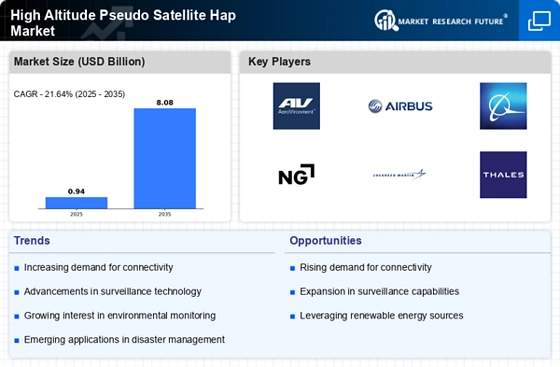Cost-Effectiveness of HAPS
The High Altitude Pseudo Satellite Hap Market is witnessing a shift towards more cost-effective solutions for aerial surveillance and communication. HAPS systems, which operate at altitudes between 20 to 50 kilometers, can cover vast areas with fewer resources compared to traditional satellites. This cost efficiency is particularly appealing to governments and organizations looking to deploy communication networks in challenging environments. The operational costs associated with HAPS are estimated to be significantly lower than those of low Earth orbit satellites, making them an attractive option for budget-conscious projects. As a result, the market is likely to see increased investment in HAPS technology.
Increased Demand for Connectivity
The High Altitude Pseudo Satellite Hap Market is experiencing a surge in demand for enhanced connectivity solutions. As the need for reliable internet access grows, particularly in remote and underserved regions, HAPS technology offers a viable alternative to traditional satellite systems. This demand is driven by the increasing reliance on digital services across various sectors, including education, healthcare, and commerce. According to recent estimates, the market for HAPS is projected to reach USD 1.5 billion by 2026, indicating a robust growth trajectory. The ability of HAPS to provide high-speed internet with lower latency compared to conventional satellites positions it as a key player in the connectivity landscape.
Advancements in Aerospace Technology
The High Altitude Pseudo Satellite Hap Market benefits from ongoing advancements in aerospace technology. Innovations in materials, propulsion systems, and energy efficiency are enhancing the performance and reliability of HAPS. These technological improvements enable longer flight durations and greater payload capacities, making HAPS more versatile for various applications, including telecommunications and surveillance. The integration of cutting-edge technologies is likely to attract investment and interest from both private and public sectors, further propelling the growth of the HAPS market. As these advancements continue, the industry is poised for significant evolution.
Strategic Partnerships and Collaborations
The High Altitude Pseudo Satellite Hap Market is characterized by an increase in strategic partnerships and collaborations among key stakeholders. Companies are recognizing the value of combining expertise in aerospace, telecommunications, and data analytics to enhance HAPS capabilities. These collaborations facilitate the sharing of resources and knowledge, leading to accelerated innovation and market penetration. For instance, partnerships between technology firms and governmental agencies can streamline the development and deployment of HAPS solutions. This trend is likely to foster a more competitive landscape, driving advancements and expanding the market reach of HAPS technology.
Growing Interest in Environmental Monitoring
The High Altitude Pseudo Satellite Hap Market is increasingly recognized for its potential in environmental monitoring applications. HAPS can provide real-time data on climate change, deforestation, and natural disasters, which is crucial for informed decision-making. The ability to gather high-resolution imagery and data from the stratosphere allows for comprehensive analysis of environmental conditions. This capability is particularly relevant as governments and organizations prioritize sustainability and environmental protection. The market for HAPS in environmental monitoring is expected to expand, driven by the need for accurate data to support climate initiatives and policy-making.


















Leave a Comment